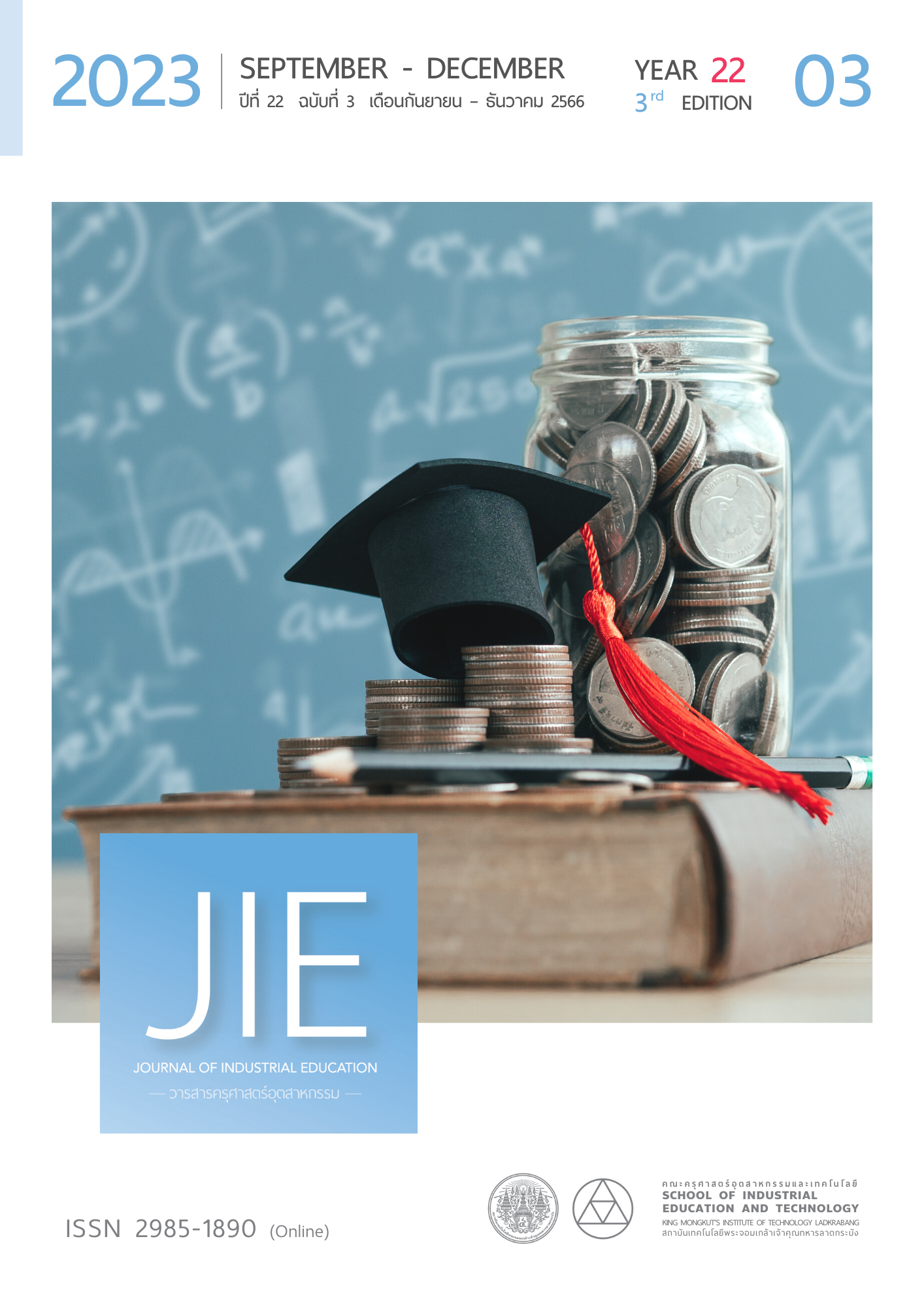DEVELOPING SELF-DIRECTED LEARNING SKILLS THROUGH THE FLIPPED CLASSROOM ACTIVITIES, CASE STUDY OF PNEUMATICS AND HYDRAULICS COURSE
Keywords:
Learning activities, Flipped classroom learning activities plan, Self-learning management planAbstract
This research presents the self-learning skill building of learners through flipped classroom activities case study of pneumatics and hydraulics course selecting a specific sample group (purposive sampling), comprising 36 third-year vocational certificate students in the auto mechanic, IRPC technology college. In this research, the course of pneumatics and hydraulics in the first semester of the academic year 2022 was evaluating the effectiveness of the lesson assessment of learning achievement and satisfaction with teaching and learning activities in a flipped classroom to build self-learning skills of vocational certificate learners. In a case study of pneumatics and hydraulics, the research tools were the learning management in four modules which included a learning achievement test before class - after class, learning activities and exercises both in the classroom and outside the classroom, the student's attributes assessment form, and a student satisfaction assessment form. Statistics were used for analyzing the data including percentage, standard deviation, and t-test.
The results of the research revealed the result of finding the quality of research tools by five experts is at an excellent level ( = 4.67, SD = 0.44). The result of the satisfaction assessment on teaching and learning management is at a good level (
= 4.32, SD = 0.12) and the result of the satisfaction assessment on learning in modules is at a good level (
= 4.30, SD = 0.08).
References
Bergmann, J., & Sams, A. (2012). Flip your classroom: Reach every student in every class every day. International Society for Technology in Education (ISTE) and the Association for Supervision and Curriculum Development (ASCD).
Biggs, J. B., & Collis, K. F. (1982). Evaluating the quality of learning: The SOLO taxonomy (structure of observed learning outcome). Academic Press.
Brookhart, S. (2013). How to create and use rubrics for formative assessment and grading. ASCD.
Boonrid, P., & Sumirattana S. (2019). A study of mathematics learning achievement and geometric thinking on circular of Mathayomsuksa 3 students learning by using the Geometer’s Sketchpad Program (GSP) with concept of flipped classroom activities. Journal of Industrial Education, 18(1), 109–118. (in Thai)
Centre for Teaching Excellence, University of Waterloo. (2022). Self-directed learning: A four-step process. https://uwaterloo.ca/centre-for-teaching-excellence/teaching-resources/teaching-tips/tips-students/self- directed-learning/self-directed-learning-four-step-process
Goedpum, N., Tungkunanan, P., & Pimdee, P. (2019). The psychomotor achievement of flipped classroom with e-learning on machanic electric and electronic. Journal of Industrial Education, 18(3), 224-231. (in Thai)
Hiemstra, R. (2013). Self-directed learning: Why do most instructors still do it wrong? International Journal of Self-Directed Learning, 10(1), 23-45.
Hiemstra, R., & Brockett, R. G. (1994). From behaviorism to humanism: Incorporating self-direction in learning concepts into the instructional design process. In: H. B. Long (Ed.), New ideas about self-directed learning pp. 59-80.
Jariya, T. (2019). Self-Directed Learning Characteristic of Undergrad Student, Faculty of Education, Bunditpatanasilapa Institute. Journal of Learning Innovation, Faculty of Education at Bunditpatanasilapa Institute, 5(1), 1-9. (in Thai)
Krumsvik, R., & Jones, L. (2013). Teacher’s digital competence in upper secondary School. Paper session presented at the International conference at Information Communication Technologies in Education, Crete.
Lapkhuntod, K., Kaewkuekool, S., & Peasura, P. (2021). The learning management with problem based learning together web based instruction on aluminum welding for production technology education students. Journal of Industrial Education, 20(2), 1-11. (in Thai)
Meearsa, J., Ponkum, S., Pinit, P., Anmanatarkul, A., & Jiracheewanun, S. (2022). Impact of constructive alignment and assessment in outcome base education on students’ learning: Case study of automotive course. Journal of Industrial Education, 21(2), 55-65. (in Thai)
Panich, V. (2013). Teacher for students create flipped classroom (2nd ed.). S.R. Printing Mass Product. (in Thai)
Palee, P., & Kamol, N. (2020). Classroom action research for promoting statistical thinking of Grade 7 students by using the five practices. Journal of Education Research Faculty of Education, Srinakharinwirot University, 15(2), 105-117. (in Thai)
Phengsoy, N., & Nokkaew, A. (2022). Alternative instructional strategies: Flipped classroom and Mathematical task practices. Journal of Industrial Education, 21(2), 74-85. (in Thai)
Phichet .K, (2016). Role of e-Learning with Self-directed learning. TUH Journal online Volume, 1(1). (in Thai)
Sajjaboriboon, T. (2021). Courseware according to a U-learning model for flipped classroom model with KWDL technique by collaborative learning using project-based learning. Journal of Yala Rajabhat University, 16(1), 89-99. (in Thai)
Sinthon, S., & Bureekhampun, S. (2020). The study and designing of Self-Directed Learning (SDL) skills enhancement activities for 10th Grade students in a technical subject. Journal of Industrial Education, 19(3), 21-31. (in Thai)
Sirapat, J., & Jaturunn, C. (2020), pp. 10-20). A Study of the Needs for Teaching Instructional Media for Hydraulics and Pneumatics Course of Students, Faculty of Industrial Education, Rajamangala University of Technology Suvarnabhumi. Journal of Nakhon Si Thammarat Rajabhat University, 12(3), 10-20. (in Thai)
Talangwit, J. (2019). Self-directed learning characteristic of undergrad student, Faculty of Education, Bunditpatanasilapa Institute. Walailak Journal of Learning Innovations, 5(1), 1-19. (in Thai)
Thornton, K. (2013). Supporting self-directed learning: A framework for teachers. In R. Stroupe & K. Kimura (Eds.), Research and practice in English language teaching in Asia (pp. 59-77). Language Education Asia.
Downloads
Published
How to Cite
Issue
Section
License
Copyright (c) 2023 Journal of Industrial Education

This work is licensed under a Creative Commons Attribution-NonCommercial-NoDerivatives 4.0 International License.
"The opinions and contents including the words in papers are responsibility by the authors."
"ข้อคิดเห็น เนื้อหา รวมทั้งการใช้ภาษาในบทความถือเป็นความรับผิดชอบของผู้เขียน"



